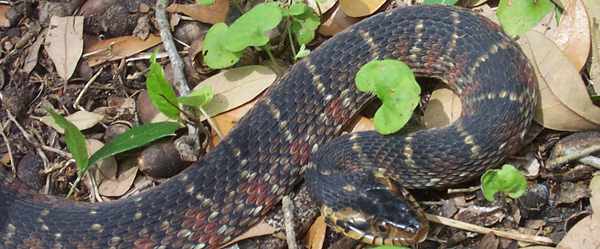- info@wildlife-removal.com
Call us for help in your town
Wildlife Removal Education
The Banded Water Snake
Need snake removal in your hometown? We service over 500 USA locations! Click here to hire us in your town and check prices - updated for year 2020.
This species of snake is one that is fairly common in the central and south east areas of the United States, and it is one that is actually non-venomous and a snake that isn't particularly harmful to people. Sadly, many people kill these snakes because they can often be mistaken for the venomous Cottonmouth snake, so knowing how to tell the difference can be very important.

Appearance
The Banded Water Snake is one that has a fairly heavy body, and has dark markings that are usually gray, dark brown or very dark in color, with bands of darker and lighter colored scales across the body of the snake.
Biology
This is one of the fairly large species of snakes, as it can grow up to three feet in length, with the largest recorded example over five feet in length. The head of the snake is quite broad and flat, and you will sometimes see lighter colored scales around the sides of the head itself.
Life Cycle
The snake is ovoviviparous, which means that it gives birth to live young, with most broods containing up to fifty baby snakes. The life span of the snake is fairly long, with those that make it into adulthood usually living for around seven to eight years.
Habitat
As the name suggests, the Banded Water Snake spends much of its life in the water, and it is one of the most successful swimmers among the snake species to be found in the United States. The species is only really found in fresh water however, and most populations of the snakes are to be found living in lakes and ponds, while it also swims strongly enough to hunt in streams and rivers too.
Diet
The diet of the snake is actually quite interesting, as smaller snakes and juveniles will actually change their hunting habits as they get older. Studies show that those up to 18 inches in length generally hunt small fish in shallow water, while the larger members of the species tend to move to hunting frogs and larger animals that will provide a little more sustenance.
Behavior
Although there are some people who keep examples of the species as pets, these snakes are not particularly friendly and will look to avoid any contact with people where possible. If there is no option for the snake to escape safely, they will release an unpleasant musk, and can also deliver a nasty bite, although they are non-venomous.
Go back to the Snake Removal page.


















